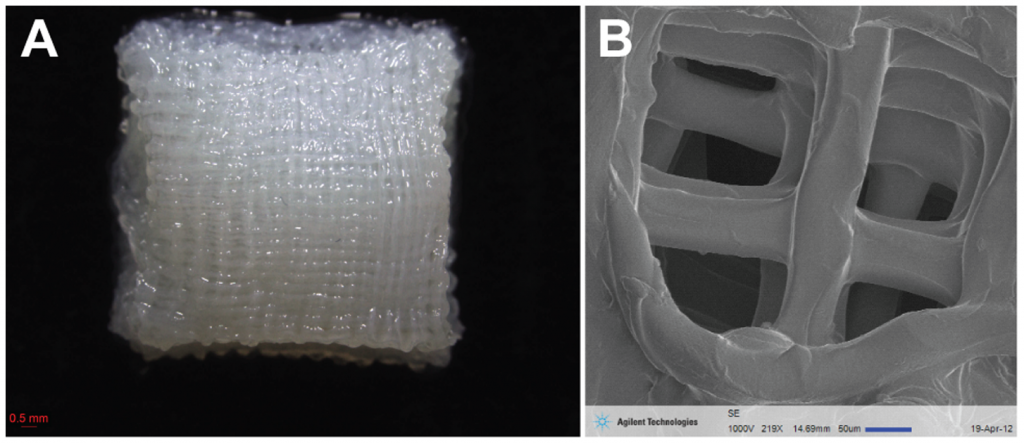What researchers call infrapatellar fat pad adipose stem cells, used in conjunction with 3D printing technology, are being employed to encourage the formation of cartilage in human tissues.
The technique uses 3D scaffold-like polymeric structures to provide an engineering framework which results in the formation of 3D tissue blocks they say can be used to repair cartilage.
They call them “3D printed chitosan scaffolds,” and the researchers say they’ve shown that seeding the stem cells into the devices can begin to form cartilage in just four weeks of growth. The pearlescent, cartilage-like matrix penetrated into the top layers of the “chitosan scaffold” to form a ‘cap’ atop the scaffold.
Called “chondrogenesis,” the process fills the scaffold, and the team says the technique could ultimately prove useful as an osteochondral graft.
Osteochondral injuries occur when the smooth surfaces on the end of bones are damaged. They can range from small cracks to a piece of the bone actually breaking off inside a joint. The fragments can be of many sizes and depths, and they can remain attached to the injured area float loosely inside the joint. They most often occur in the knee, ankle, or elbow.
 The researchers include Ken Ye, Raed Felimban, Peter F. M. Choong, and Damian E. Myers from the Department of Surgery at St Vincent’s Hospital, University of Melbourne; Kathy Traianedes and Anita Quigley from the Departments of Medicine and Clinical Neurosciences at St Vincent’s; and Simon E. Moulton, Gordon G. Wallace, and Johnson Chung of the Intelligent Polymer Research Institute at the University of Wollongong ARC Centre of Excellence for Electromaterials Science. They say cartilage defects have limited capacity for self-regeneration and healing.
The researchers include Ken Ye, Raed Felimban, Peter F. M. Choong, and Damian E. Myers from the Department of Surgery at St Vincent’s Hospital, University of Melbourne; Kathy Traianedes and Anita Quigley from the Departments of Medicine and Clinical Neurosciences at St Vincent’s; and Simon E. Moulton, Gordon G. Wallace, and Johnson Chung of the Intelligent Polymer Research Institute at the University of Wollongong ARC Centre of Excellence for Electromaterials Science. They say cartilage defects have limited capacity for self-regeneration and healing.
Their work centers on the methods to treat such cartilage damage. This sort of condition often results in pain and loss of function for patients, and can even accelerate the development of osteoarthritis in a joint. As it stands, what are called osteochondral repairs are limited to microfracture, grafting, and chondrocyte transplantation. The problem with those treatments is that they’re likely to result in the formation of fibrocartilage. Fibrocartilage is tough and dense material that fills in around a torn section of cartilage, and it’s not the ideal replacement for the sort of smooth, glassy articular cartilage that normally covers the surface of joints. When it forms, it often leads to a poor long-term result for a patient.
But the scientists are looking for treatments which solve those problems, and they say tissue engineering like this may well offer treatment options capable of overcoming the limitations of current options.
By combining cells, scaffold, and biochemical factors, the scientists say they’re on the cusp of reaching their goal: “true cartilage regeneration.”
To make it happen, the team built 3D structures aimed at mimicking the actual, existing cartilage environment, and they think that similarity will provide a better environment for the cartilage regeneration. You can read about the work in detail here.
The various technologies of 3D printing are being used to advance the cause of medical science every day. Have you heard about a novel technique or application of 3D printing in medicine? Please comment about this story or let us know about your experience in the field in the 3D Printed Scaffolds to Repair Your Joints forum thread on 3DPB.com.
Subscribe to Our Email Newsletter
Stay up-to-date on all the latest news from the 3D printing industry and receive information and offers from third party vendors.
You May Also Like
3D Printing Financials: Steakholder Foods Balances Losses and 3D Printed Tech Advances in 2023
A pioneer in the field of 3D printed meat and fish, Steakholder Foods (Nasdaq: STKH) disclosed its 2023 financial results, a year highlighted by technological progress but overshadowed by financial...
3D Printing Financials: Protolabs’ Q1 3D Printing Revenue is Flat, Company Advances in Technology Push
Protolabs (NYSE: PRLB) has kicked off 2024 with a mild boost in revenue, revealing how the Minnesota-based company manages to adapt and thrive even in uncertain market conditions. While the...
Supply Chain Management and the Role of 3D Printing Digital Inventories
As the additive manufacturing (AM) industry grows beyond its humble roots as a rapid prototyping technology, it has been adopted by some of the world’s leading companies to produce not...
3D Printing Financials: Materialise’s Profitability Amid Revenue Dip in Q1 2024
Materialise (Nasdaq: MTLS) has released its first-quarter earnings for 2024, highlighting a challenging quarter with some key advances despite a dip in revenue. While navigating a mixed performance across its...
































